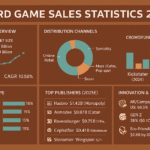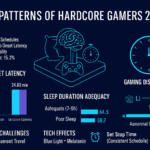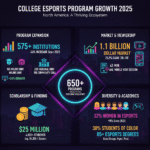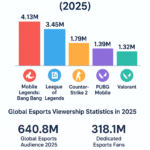Gaming Hardware Upgrade Frequency Statistics 2025
The gaming hardware market reached an unprecedented milestone in 2025, with spending hitting $44.5 billion globally. This surge reflects how frequently modern gamers refresh their systems to keep pace with demanding titles and emerging technologies. Understanding upgrade cycles helps gamers make informed decisions about when to invest in new components.
How Often Do Gamers Upgrade Their PC Components
Gaming PC upgrade frequency varies significantly across different hardware categories. The typical refresh timeline depends on multiple factors including budget constraints, performance requirements, and technological advancement rates.
Most gamers follow distinct upgrade patterns that prioritize graphics cards over other components. This makes sense given how directly GPU performance impacts gaming experiences and visual quality. Meanwhile, processors and memory follow slower replacement cycles unless platform transitions force earlier upgrades.
GPU Upgrade Cycle: How Often Do Gamers Replace Graphics Cards
Graphics cards experience the shortest upgrade intervals among gaming components. Enthusiast gamers typically replace GPUs every 22 months, driven by new features like advanced ray tracing, AI upscaling, and frame generation technologies.
The broader gaming population maintains longer replacement cycles. Mainstream users stretch GPU upgrades to three to five years, balancing performance needs against purchase costs. This extended timeline works for gamers satisfied with medium settings or those gaming at 1080p resolution.
Current GPU Market Trends From Steam Hardware Survey
Steam Hardware Survey data reveals interesting patterns in graphics card adoption. The RTX 4060 currently leads at 4.85 percent market share, slightly ahead of the RTX 3060 at 4.79 percent. This narrow margin demonstrates how refresh cycles overlap generations.
Early adoption of RTX 50-series cards remains modest but growing. The RTX 5070 holds 1.57 percent share among Steam users, indicating cautious uptake of the newest generation. Many gamers wait for price stabilization and driver maturity before committing to the latest hardware.
VRAM capacity continues shifting upward. While 8GB configurations still dominate at approximately 34 percent, this represents a decline. Cards with 16GB VRAM saw the largest gains, reaching 7.5 percent market share as modern games demand more video memory for high-resolution textures.
CPU and Platform Upgrade Frequency
Processor upgrades follow slower cycles than graphics cards. Most gamers replace CPUs and motherboards every five to seven years, typically triggered by socket changes or major architectural shifts rather than incremental performance gains.
Platform transitions create forced upgrade waves. Windows 11 hardware requirements are pushing over 100 million gamers to upgrade CPUs, motherboards, and memory simultaneously. This represents the first time an operating system update has mandated such widespread hardware changes for the gaming community.
| Month | Intel | AMD |
|---|---|---|
| May 2025 | 60.44% | 39.48% |
| July 2025 | 59.52% | 40.39% |
| September 2025 | 58.61% | 41.31% |
AMD Gaining Ground in Gaming CPU Market
AMD continues capturing market share from Intel throughout 2025. The trend reflects strong reception of X3D processors optimized for gaming workloads. These chips deliver performance advantages in titles sensitive to cache size and memory latency.
The competitive landscape benefits gamers. When players decide to upgrade processors, they now have compelling options from both manufacturers at various price points. This competition drives innovation while keeping prices more reasonable than monopolistic scenarios would allow.
How Often Gamers Upgrade RAM
System memory upgrades occupy middle ground between GPU and CPU replacement cycles. Typical RAM refresh intervals span four to six years, though this timeline is compressing as games demand more capacity.
A significant shift is occurring in 2025. Steam Hardware Survey data shows 16GB configurations declining from 43.12 percent to 41.67 percent over six months. Meanwhile, 32GB systems jumped from 32.85 percent to 35.42 percent during the same period. Current trends suggest 32GB will become the dominant configuration before year end.
Why RAM Upgrade Cycles Are Accelerating
Several factors drive faster memory upgrades. Modern triple-A titles increasingly specify 32GB as recommended requirements. Games like Star Wars Outlaws and Black Myth Wukong demonstrate noticeable performance improvements with additional memory headroom.
Multitasking while gaming pushes memory needs higher. Many gamers run Discord, browser tabs, and streaming software alongside their games. This concurrent usage makes 16GB feel constrained compared to the breathing room 32GB provides. For competitive players who need every advantage, having extra RAM eliminates potential bottlenecks during intense FPS matches.
DDR5 pricing dynamics also influence upgrade timing. While DDR4 costs increased approximately seven percent in 2025, DDR5 prices dropped around three percent. This inverted pricing makes jumping to current-generation memory more attractive than extending DDR4 system lifespans.
Storage Upgrade Patterns and Frequency
Storage experiences the longest replacement cycles among major gaming components. Traditional refresh intervals stretch six to eight years for SSDs, though capacity constraints increasingly push gamers to upgrade earlier.
Game file sizes create pressure for more storage. Modern titles routinely exceed 100GB, with some installations demanding 150GB or more. These ballooning requirements force capacity-driven upgrades even when existing SSDs still function perfectly.
The transition from PCIe 4.0 to 5.0 proceeds slowly. Most gamers see minimal real-world benefits from the latest interface speeds in actual gameplay. Load time differences between PCIe 4.0 and 5.0 often measure in fractions of a second, making this upgrade low priority compared to other components.
Complete Hardware Upgrade Frequency Overview
Synthesizing upgrade patterns across all components reveals a clear hierarchy. Graphics cards refresh fastest, followed by RAM, then CPUs and platforms, with storage bringing up the rear.
| Component | Typical Refresh Interval | Primary Drivers |
|---|---|---|
| GPU | 1.8 – 5 years | Ray tracing, DLSS, AI features, resolution demands |
| CPU / Platform | 5 – 7 years | Socket changes, architecture leaps, OS migrations |
| RAM | 4 – 6 years | Capacity requirements, speed improvements |
| Storage | 6 – 8 years | Game size inflation, capacity needs |
Gaming Hardware Upgrade Frequency by Budget Tier
Budget constraints significantly affect how often gamers upgrade their PC components. Entry-level builders typically maintain systems longer, sometimes extending hardware lifecycles to seven or eight years before complete replacements become necessary.
Mid-range gamers strike balance between performance and value. This segment usually refreshes key components every three to four years, timing purchases around major price drops or generational transitions. They often skip one hardware generation before upgrading.
High-end enthusiasts operate on aggressive upgrade schedules. Some refresh graphics cards with every major release, though even dedicated hardware enthusiasts increasingly question whether annual GPU upgrades deliver sufficient value. The diminishing returns between consecutive generations have moderated upgrade frequency even among this demographic.
Factors Accelerating Gaming PC Upgrade Cycles in 2025
Multiple converging trends compress traditional upgrade timelines. Understanding these drivers helps gamers anticipate when their current hardware might feel inadequate for newer gaming releases.
Windows 11 Migration Impact
The Windows 11 transition represents an unprecedented forced upgrade wave. Hardware requirements exclude millions of older systems, compelling gamers to replace CPUs, motherboards, and sometimes memory to maintain operating system support and security updates.
This migration affects approximately 100 million gaming PCs globally. The concentrated upgrade demand creates supply pressure and influences pricing across multiple component categories simultaneously. Many gamers who planned longer hardware lifecycles find themselves upgrading earlier than originally intended.
Next-Generation GPU Features
RTX 50-series cards introduce compelling technologies that entice upgrades. The combination of PCIe 5.0 support, GDDR7 memory, and enhanced AI capabilities provides meaningful improvements over previous generations. Features like improved frame generation and AI-powered upscaling deliver tangible performance benefits in demanding titles.
VRAM requirements escalate with each new game engine iteration. Titles built on Unreal Engine 5 frequently specify 12GB or 16GB VRAM for optimal settings. This pushes gamers with 8GB cards toward earlier upgrades than past generations required, even if their GPUs otherwise deliver acceptable frame rates.
Game Engine Evolution
Modern game engines demand substantially more from hardware. Unreal Engine 5 features like Nanite and Lumen stress both GPU and CPU resources in ways previous engines did not. These technologies enable unprecedented visual fidelity but require corresponding hardware capabilities to maintain smooth performance.
The shift toward higher baseline specifications affects upgrade frequency across the performance spectrum. Games that once ran acceptably on mid-range hardware now require high-end components for similar experiences. This acceleration in system requirements shortens the effective lifespan of existing hardware configurations.
Memory Baseline Shifts
The transition from 16GB to 32GB as the standard gaming RAM capacity represents a significant threshold. Many gamers who recently upgraded to 16GB discover this amount no longer provides comfortable headroom for current titles combined with background applications.
This creates frustration and drives earlier-than-planned memory upgrades. The situation parallels previous transitions from 8GB to 16GB, though the current shift proceeds more rapidly due to concentrated demand from AAA developers targeting next-generation console specifications.
Regional Differences in Gaming Hardware Upgrade Frequency
Geographic factors significantly influence how often gamers upgrade their systems. North American users lead in upgrade frequency, with 41 percent refreshing at least one hardware component annually. Higher disposable income and robust gaming culture contribute to this aggressive replacement cycle.
The Asia-Pacific region demonstrates the fastest growth rates despite lower absolute upgrade frequency. Projected compound annual growth rates of 10 to 12 percent through 2032 reflect expanding gaming populations and rising incomes. Strong esports presence in countries like South Korea and China drives demand for cutting-edge hardware among competitive players.
European markets show moderate upgrade patterns. Gamers in this region tend toward value-oriented purchases, often extending hardware lifecycles beyond North American averages. Price sensitivity and different taxation structures influence replacement decisions across European countries.
Laptop vs Desktop Gaming Hardware Refresh Cycles
Gaming laptop upgrades follow fundamentally different patterns than desktop systems. The limited upgradeability of mobile hardware forces complete system replacements rather than component-level refreshes.
Desktop gamers enjoy flexibility in upgrade timing. The ability to replace individual components as budgets allow or needs dictate extends effective system lifespans. A desktop built five years ago might receive a new GPU this year, more RAM next year, and continue serving adequately without full replacement.
Despite upgrade limitations, laptop gaming continues growing. The segment projects over 14 percent compound annual growth from 2025 through 2030, driven by demand for portable high-performance solutions. Manufacturers increasingly offer 32GB RAM configurations in gaming laptops, acknowledging the importance of future-proofing mobile systems against accelerating software requirements.
How to Determine When to Upgrade Gaming Hardware
Deciding optimal upgrade timing requires evaluating multiple factors beyond simple hardware age. Performance dissatisfaction provides the clearest signal that upgrades deliver value. When frame rates consistently fall below target thresholds or games require reduced settings for playability, hardware refresh becomes justified.
Monitor bottlenecks during gameplay. Tools like MSI Afterburner reveal whether GPU, CPU, or RAM constraints limit performance. This information helps prioritize which components deserve upgrade attention first. Replacing a bottlenecked component delivers immediately noticeable improvements, while upgrading non-limiting hardware wastes money on unneeded capability.
Consider generational leaps rather than incremental upgrades. Jumping two or three hardware generations typically provides more noticeable improvements than replacing components with immediate successors. This approach extends time between purchases while delivering meaningful performance gains when upgrades occur.
Budget-Conscious Upgrade Strategies
Smart upgrade planning maximizes value from limited budgets. Timing purchases around major sales events like Black Friday or Prime Day can reduce costs by 15 to 30 percent for identical hardware. Patient shoppers who track pricing trends often secure better deals than those buying impulsively.
The used hardware market offers compelling value for budget-focused gamers. Previous-generation components frequently sell at significant discounts when new releases arrive. A year-old high-end GPU often outperforms current mid-range options while costing less, making used hardware purchases strategic for performance-per-dollar optimization.
Prioritize upgrades that eliminate bottlenecks first. Adding RAM when memory usage maxes out delivers immediate improvements. Upgrading storage from HDD to SSD transforms load times dramatically. These targeted component replacements often provide better real-world experience improvements than more expensive GPU upgrades when existing graphics cards already deliver acceptable frame rates.
Future Trends in Gaming Hardware Upgrade Cycles
Cloud gaming threatens to disrupt traditional hardware upgrade patterns. Services offering high-end gaming experiences without local hardware requirements could extend or even eliminate upgrade cycles for some users. However, enthusiasts prioritizing response times and visual quality will likely continue maintaining local gaming systems.
AI integration across gaming hardware changes the upgrade value proposition. Features like DLSS 3 and frame generation extend effective GPU lifespans by delivering playable performance from hardware that would otherwise struggle. This technology could slow upgrade frequency as older cards remain viable longer through intelligent upscaling.
Component pricing volatility introduces uncertainty into upgrade planning. Supply chain disruptions, tariff implementations, and cryptocurrency mining demand all influence hardware costs unpredictably. These factors may force gamers to adjust upgrade timing based on market conditions rather than pure performance considerations.
FAQs
How often should you upgrade your gaming PC?
▼Most gamers upgrade individual components every three to five years rather than replacing entire systems. Graphics cards typically need replacement every 1.8 to 5 years depending on performance requirements, while CPUs last five to seven years. RAM upgrades occur every four to six years, and storage replacements happen every six to eight years or when capacity becomes insufficient.
What gaming PC component should I upgrade first?
▼Upgrade the component creating performance bottlenecks first. Use monitoring tools to identify whether GPU, CPU, RAM, or storage limits gaming performance. Graphics cards provide the most noticeable gaming improvements when upgraded, but only if GPU constraints actually limit frame rates. If RAM usage maxes out or CPU utilization hits 100 percent during gameplay, those components deserve priority instead.
Is 16GB RAM still enough for gaming in 2025?
▼16GB RAM remains functional for gaming in 2025 but increasingly feels constrained. Steam Hardware Survey shows 32GB configurations steadily gaining market share as modern AAA titles specify higher memory requirements. Gamers who stream, browse, or run multiple applications while gaming benefit significantly from 32GB. The transition to 32GB as the standard gaming configuration is expected to complete before year end based on current adoption trends.
How long do gaming GPUs typically last?
▼Graphics cards physically function for many years, but their effective gaming lifespan varies. Enthusiast gamers replace GPUs every 22 months to maintain cutting-edge performance, while mainstream users stretch upgrades to three to five years. The actual replacement timing depends on target frame rates, resolution, and willingness to reduce graphics settings as games become more demanding.
Should I upgrade my CPU or GPU first for gaming?
▼GPU upgrades typically deliver larger gaming performance improvements than CPU replacements. Most modern titles stress graphics cards more than processors. However, if CPU usage hits 100 percent during gameplay while GPU utilization remains lower, or if minimum frame rates suffer despite acceptable average FPS, processor upgrades take priority. Games optimized for console hardware particularly benefit from CPUs with strong single-thread performance.
Is it worth upgrading from DDR4 to DDR5 for gaming?
▼DDR5 provides measurable but modest gaming performance improvements over DDR4. Frame rate gains typically range from five to fifteen percent depending on the specific game and CPU combination. The upgrade makes more sense during platform transitions requiring new motherboards anyway. With DDR5 prices declining while DDR4 costs increase, new builds should use DDR5, but DDR4 system owners need not rush upgrades purely for gaming benefits.
How often do professional esports players upgrade their gaming PCs?
▼Professional esports players maintain aggressive upgrade cycles, often refreshing key components annually or with each major hardware release. Competitive advantage from higher frame rates and lower latency justifies frequent upgrades in professional contexts. However, 70 percent of esports players choose desktop systems over gaming laptops specifically for superior upgradeability and peak performance, even though this requires more frequent component attention.
What factors should influence my gaming hardware upgrade timing?
▼Multiple factors inform optimal upgrade timing including current performance dissatisfaction, budget availability, hardware pricing trends, and upcoming game releases. Major platform transitions like Windows 11 migration sometimes force upgrades earlier than planned. Generational hardware leaps typically deliver better value than incremental updates, so waiting for significant technological improvements often makes more sense than replacing components with immediate successors.
Sources
- Quantumrun. “Gaming Hardware Upgrade Frequency 2025.” Quantumrun Foresight. https://www.quantumrun.com/consulting/gaming-hardware-upgrade-frequency/
- Tom’s Hardware. “32GB of RAM on track to become the new majority for gamers — Steam survey indicates shift could occur before the end of the year.” https://www.tomshardware.com/pc-components/ram/32gb-of-ram-on-track-to-become-the-new-majority-for-gamers
- Dataconomy. “PC Gaming Hardware Market To Reach $44.5B By The End Of 2025.” https://dataconomy.com/2025/09/22/pc-gaming-hardware-market-to-reach-44-5b-by-the-end-of-2025/
- Gaming News. “Steam Hardware Survey August 2025: Key Changes, Trends, and Takeaways.” https://gaming.news/codex/steam-hardware-survey-august-2025-key-changes-trends-and-takeaways/





